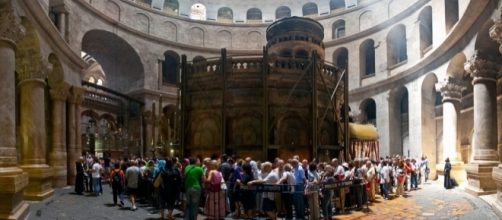Archaeologists were recently allowed to enter the innermost chamber where Jesus of Nazareth was said to have been buried three days before being resurrected. A team of historians and restorers have been working inside the Edicule – a chamber built around the ancient cave – and have discovered what many feel is the original surface where Jesus Christ was laid to rest.
Original surfaces located behind the marble walls and shelves
While many assumed the original cave walls and shelf where Jesus was entombed were destroyed thousands of years ago, the restoration team, using ground penetrating radar, announced that theFirst Centurycave walls are still standing behind the now-marbled over chamber walls.
What’s more, underneath the slab was a layer of debris, and a second marble slab, etched with a cross and dating back to the 12th Century, was found. Beneath that, a white rock is thought to be the very rock that Christ, enshrouded in burial wrappings, was said to have been placed. Debris and other material found under the first marble slab were for sent for tests and studying.
National Geographic archaeologist Fredrik Hiebert, on site, said, “What was found is astonishing… My knees are shaking a little bit.
Jesus' tomb, according to the Bible
The tomb where Jesus was said to be buried was donated by Joseph of Arimathea, a wealthy man who was also a secret disciple of Jesus and a member of the Jewish high court of the Sanhedrin.
Perhaps due to his political and religious status, Joseph did not openly identify himself as a follower of Jesus, although the scriptures tell us that he did not support the unlawful actions of his judicial counterparts. After Jesus died, he asked for the body of Christ from Pontius Pilate, prepared it for burial and placed it inside the tomb, cut into the face of a limestone rock wall.
The tomb itself, much like those purchased by Jerusalem's wealthy, was a vault, hand cut into a wall of rock. A circular stone, evidently on some sort of track, was used to close the entrance. Inside, bench-like shelves or niches for one or more bodies would have been cut vertically into the walls of the cave.
Two locations?
While the present-day Church of the Holy Sepulchre marks the traditional location where most believe Christ was entombed, others feel that the Garden Tomb, another rock-cut tomb located in what was once Golgotha, a location outside of Jerusalem where Jesus was impaled, is the true burial place. No definitive proof exists to support either location.
The Church 'assigned' a location for Jesus
In Church history, the decision to “assign” a burial place for Jesus – and thus serve as a locale for worship throughout the centuries – was taken on by Emperor Constantine. He in turn tasked the decision to Macarius, a Bishop of Jerusalem who served from 312 to 335 AD. Bishop Macarius was also told to search for the site of Jesus’ resurrection, and for the cross or upright stake that Jesus died on.
At the time, Macarius determined that the Temple of Aphrodite stood on the site where Jesus was buried, and razed the temple. In its place, he erected a basilica that later became the Church of the Holy Sepulchre.
Shroud of Turin
Another relic related to Jesus death, perhaps the most famous, is the winding sheet called the Shroud of Turin, believed by many to be the cloth that the body of Christ was wrapped in and cited as the source of the commonly accepted image of what Jesus looked like. Locked up under an airtight and bulletproof viewing container in a cathedral in Turin, Italy, the shroud has been debunked both by science – carbon-dating placed its origin onlyto the 12th century – and Scripture, which show that Jesus was not covered in a single sheet, but with cloths, including a separate cloth used to wrap his head. (John 20:5-7)
See also: Should a Christian celebrate Halloween?

